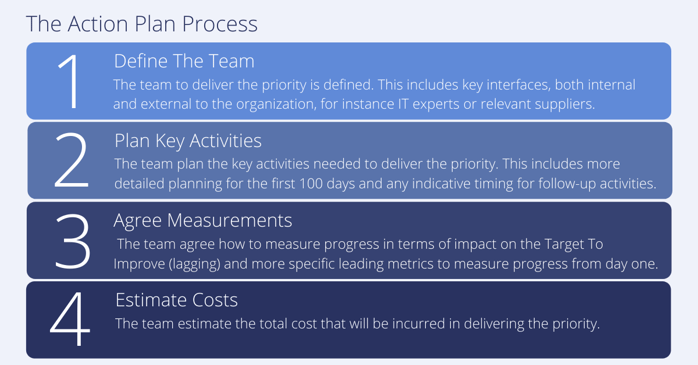In previous blogs I explained what Hoshin Kanri is and the function of the X-Matrix in Hoshin Kanri strategic planning. In this blog, I look at the integral role of the Hoshin Action Plan in the strategic planning process.
Written by: Carolyn Gibson, Senior Strategy Advisor
In my blog 'What is Hoshin Kanri?' I explained that Hoshin Kanri helps you successfully deliver on your strategic plan by creating focus, alignment and accountability.
One of the key parts of this process is catchball, whereby key managers and their teams work together not just to select the key areas of focus but also to articulate what it will take to deliver on their promises.
The Action Plan is a cornerstone of this process, and this blog addresses its role in helping to drive engagement in your goals.
Action Plans are an essential element of catchball
Action Plans are a staple of project management, but in the context of the Hoshin Kanri catchball process it takes on heightened importance. In fact, building an Action Plan is as important as its final content as shown in the X-Matrix and Bowling Chart.
When an executive is made accountable for a key Improvement Priority, before accepting responsibility they must bring together the key people in the organization they believe will need to be involved in delivering on that priority.
Together, these people consider the Improvement Priority and the specific “target to improve” (the lagging metric), and undertake four primary activities.

With this information, the accountable owner can initiate discussions within the executive team to explain the plan and get agreement as to resourcing and timing, making any modifications to the improvement priority and the Action Plan as necessary to finalize agreement.
The Action Plan A3
The Action Plan that results need not be more than an A3 page, and typically then has the following sections:
- A brief description of the Improvement Priority that the Action Plan is addressing;
- A brief description of the metric associated with that priority (the target to improve and how it will be measured)
- A brief description of the general approach to achieving the priority
- A list of the team members who will be involved
- The indicative budget
- A high-level Gantt chart of the key activities, their owners, and the projected impact of each activity on the lagging metric
- A list of any leading metrics that will be used to measure early progress.
Action Plan results
I trust that you can see now how the development and agreement of each Improvement Priority’s Action Plan creates the necessary focus and accountability.
The third Hoshin element, alignment, comes from executive agreement to the complete set of Action Plans before the Hoshin Plan can move from planning to execution.
The executive team must understand and agree to resource and timing interdependencies from the outset to ensure smooth execution.
Furthermore, the Action Plans inform the launch preparation phase, which includes team formation, resources procurement and allocation, and any preparatory training.
The principles of the Action Plan
Action Plans should be constructed using three intrinsic principles: high level view; outside-in thinking; and measurement focus.

What the Action Plan isn't
High-level view: It is NOT a full project initiation document, although it can form the basis for it.
Outside-in Thinking: It is about breaking down barriers NOT building them up.
Measurement Focus: It is NOT about waiting until the end to see if it has worked or not.
Tool options
An Action Plan template can be created in PowerPoint or in Excel - click here for some examples.
Of course, project planning software can also be used.
For the most benefit, Hoshin software packages can provide links between Improvement Priorities, Metrics (Targets to Improve, Leading Metrics) and Action Plans in the planning phase.
This removes non-value add rekeying of data, retains consistency and thus improves alignment and overall manageability of the plan.
A final word from Sun Tsu
“Strategy without tactics is the slowest route to victory, tactics without strategy is the noise before defeat.”
The Action Plan is the tactics required to deliver your strategy, and as such is the link between strategy and action.
While doing it well takes time, it is the only way to achieve true focus, accountability and alignment, and thus is the quickest way to success.
Continue learning about Hoshin Kanri
Click here for further information on Hoshin Kanri, and stay tuned for the next blog on the Bowling Chart and how it is used to measure success.
For more, continue your journey with these recommendations:
- The Hoshin Kanri X-Matrix: The What, How, Why, Benefits and more: Discover how the X-Matrix works and how you can make your own in our free Excel template
- Danaher, Ingersoll Rand and Xerox: Policy Deployment in Practice: Learn why the experiences of these companies can teach us a lot about adopting Policy Deployment / Hoshin Kanri.
- Download our Hoshin Kanri eBook: Read how Hoshin Kanri is supporting organizations to drive great business results, how two businesses have used the methodology to build their business systems, case studies and more.
About the author
Carolyn Gibson is a senior strategy advisor and certified Hoshin Kanri facilitator working with Fortune 500 companies on building their Strategy Execution capabilities. Her career spans disciplines, industries and locations for over twenty years, with a golden thread running throughout of an obsessive focus on the mechanical detail of how organizations achieve their goals.




